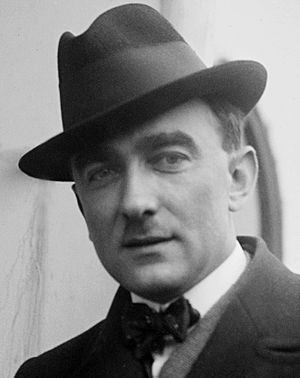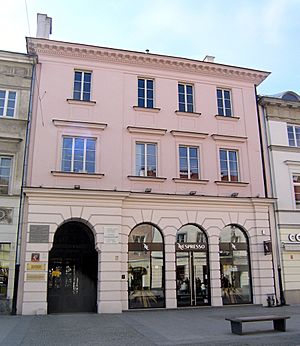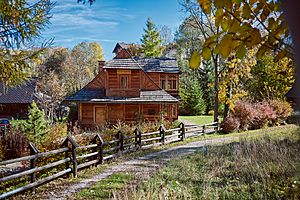Karol Szymanowski facts for kids
Quick facts for kids
Karol Maciej Szymanowski
|
|
|---|---|
 |
|
| Background information | |
| Born | 6 October 1882 |
| Died | 29 March 1937 (aged 54) |
| Genres | Classical |
| Occupation(s) | Composer |
| Instruments | Piano |
Karol Maciej Szymanowski (born October 6, 1882 – died March 29, 1937) was a famous Polish composer and pianist. He was a key part of the modernist "Young Poland" movement. This group of artists was active in the late 1800s and early 1900s.
Szymanowski's early music showed influences from late Romantic German composers. He was also inspired by the early works of Alexander Scriabin. Examples include his Étude Op. 4 No. 3 and his first two symphonies. Later, his style became more impressionistic. This means his music focused on creating a certain mood or atmosphere. He also used some atonal sounds, which means music without a clear main key. You can hear this in his Third Symphony and his Violin Concerto No. 1.
His final period of music was inspired by the folk music of the Polish Górale people. This influence can be heard in his ballet Harnasie, his Fourth Symphony, and his piano Mazurkas. King Roger, an opera he wrote between 1918 and 1924, is still his most well-known work. Other important pieces include Hagith, Symphony No. 2, The Love Songs of Hafiz, and Stabat Mater.
Szymanowski received many top national awards. These included the Officer's Cross of the Order of Polonia Restituta and the Order of Merit of the Republic of Poland. He also earned other honors from Poland and other countries.
Contents
Life and Career
Early Life and Education
Karol Szymanowski was born into a wealthy Polish family in Tymoszówka. This village was then part of the Russian Empire, but it is now in Ukraine. His family moved back to Warsaw in the mid-1920s.
He first learned music at home from his father. In 1892, he joined the Gustav Neuhaus Elisavetgrad School of Music. From 1901 to 1905, he studied at the State Conservatory in Warsaw. Later, from 1926 to 1930, he became the director of this same conservatory. During his time there, he met many famous Polish artists. These included Artur Rubinstein, Grzegorz Fitelberg, and Stefan Żeromski. Because there were not many musical chances in Poland at the time, he traveled a lot. He explored different parts of Europe and North Africa.
His Musical Journey

In Berlin, Szymanowski helped start the Young Polish Composers’ Publishing Company. This company aimed to publish new music by Polish artists. This was from 1905 to 1912. While living in Vienna (1911-1914), he wrote the opera Hagith. He also created two song cycles called The Love Songs of Hafiz. These works show a change in his musical style.
Szymanowski could not join the military during World War I because of a knee injury. So, between 1914 and 1917, he focused on composing. He also spent time studying Islamic culture, ancient Greek drama, and philosophy. His music from this time is very original and diverse. Examples include Mity (1914; “Myths”), Metopy (1915; Métopes), and Maski (1916; “Masques”). In these works, his music became less extreme in its loud and soft parts. He started using colorful orchestration and polytonal (using more than one key at once) or atonal (no clear key) sounds. However, he still kept the expressive melodies from his earlier works.
Szymanowski moved to Warsaw in 1919.
Later Life and Passing
In 1926, Szymanowski became the Director of the Warsaw Conservatory. He became very ill in 1928 and had to leave his job for a while. He was diagnosed with a serious lung illness called tuberculosis. In 1929, he traveled to Davos, Switzerland, to get medical help.
Szymanowski returned to his director position in 1930. However, the school closed two years later. He then moved to Villa Atma in Zakopane. There, he composed with great energy. In Zakopane, Szymanowski became very interested in Polish folk music. He wanted to create a unique Polish national style in music. This was a goal not really tried since the time of Chopin. He learned a lot about the culture of the Polish Highlanders (Gorals). He used their musical sounds, rhythms, and melodies in his own compositions.
In 1936, Szymanowski received more treatment in Grasse, France. But sadly, it did not help. He passed away at a sanatorium in Lausanne, Switzerland, on March 29, 1937. His sister, Stanisława, brought his body back to Poland. He was buried at Skałka in Kraków. This place is known as the "national Panthéon" for important Poles.
Influences
Szymanowski was inspired by many other composers. These included Richard Wagner, Richard Strauss, Max Reger, Alexander Scriabin, Claude Debussy, and Maurice Ravel. He was also greatly influenced by his fellow countryman Frédéric Chopin.
A big part of his inspiration came from Polish folk music. Like Chopin, he wrote many mazurkas for the piano. He was especially influenced by the folk music of the Polish Highlanders. He discovered this music in Zakopane, in the southern Tatra highlands. He once wrote that finding the beauty of Goral music, dance, and buildings was very personal to him. He felt he had absorbed much of this beauty into his soul.
Music experts say that Goral music is played on two fiddles and a string bass. It has unique and "exotic" qualities, with interesting sounds and effects. Aleksander Laskowski, a music expert, said that Szymanowski "invented a musical language." He added that Szymanowski's works were "true and ingenious creations." His music showed amazing growth, from being influenced by Wagner to having a romantic "Oriental period." Finally, he developed a national style inspired by his time in the Tatras.
Works
You can find a full list of his works at List of compositions by Karol Szymanowski.
Some of Szymanowski's most famous orchestral pieces include his four symphonies. These are No. 3, Song of the Night, which includes a choir and singers, and No. 4, Symphonie Concertante, which features a piano. He also wrote two violin concertos.
His stage works include the ballets Harnasie and Mandragora. He also composed the operas Hagith and King Roger.
Szymanowski wrote a lot of music for the piano. This includes his four Études, Op. 4, where No. 3 was once his most popular piece. He also wrote many mazurkas and Métopes. Other works include the Three Myths for violin and piano, and Nocturne and Tarantella. He also composed two string quartets, a sonata for violin and piano, and several orchestral songs. Some of these songs used words by poets like Hafiz and James Joyce. His Stabat Mater is another important work.
Recognition
Szymanowski's music became known around the world. In the 1920s and 1930s, his music was very popular. Famous soloists like Artur Rubinstein and Joseph Szigeti performed his works. Orchestras led by conductors such as Leopold Stokowski and Willem Mengelberg also played his music.
Performances of his Stabat Mater in Europe and America were big events. They were successful in cities like Naples, Paris, New York, and Chicago. His opera King Roger was performed in Prague in 1932. It was a huge success and showed Szymanowski's own vision for the piece. The ballet Harnasie was also very popular on stage.
In 1932, a Polish recording of his Symphony No. 4 was made. This led to many performances of the symphony in other countries. Often, Szymanowski himself played the piano part, and Grzegorz Fitelberg conducted. The symphony was performed in London, Moscow, Paris, and many other cities between 1933 and 1937.
Recordings
In 1994, Charles Dutoit recorded both of Szymanowski's violin concertos with the Montreal Symphony Orchestra. The English conductor Sir Simon Rattle has called Szymanowski "one of the greatest composers of this [20th] century." He has made several recordings with the Birmingham Symphony Orchestra.
In 2004, Scottish violinist Nicola Benedetti won the BBC Young Musician of the Year award. She won with a performance of Szymanowski’s Violin Concerto No. 1. In 2008, King Roger was performed at the Edinburgh International Festival. Valery Gergiev led the Mariinsky opera company for this performance. In 2012, Gergiev also led the London Symphony Orchestra in performing all four of Szymanowski's symphonies at the same festival.
In 2015, King Roger was staged at London's Royal Opera House. In the last twenty years, Szymanowski's music has become popular again. It is performed and recorded by many famous conductors and musicians around the world. These include Pierre Boulez, Edward Gardner, and Krystian Zimerman.
Remembrance

Szymanowski received many awards during his lifetime. These included the Officer Cross of the Order of Polonia Restituta and the Knight of Legion d'Honneur. He also received honorary degrees and was a member of several important music academies.
On November 16, 2006, the Polish Parliament declared 2007 "The Year of Karol Szymanowski." This was to honor the 125th anniversary of his birth and the 70th anniversary of his death. On October 3, 2007, the National Bank of Poland released special coins with Szymanowski's image. These coins came in different values.
The Karol Szymanowski Academy of Music in Katowice and the Kraków Philharmonic are both named after him. On November 11, 2018, to celebrate 100 years of Polish independence, President Andrzej Duda gave Szymanowski Poland's highest award, the Order of the White Eagle. This award was given to him after his death.
See also
 In Spanish: Karol Szymanowski para niños
In Spanish: Karol Szymanowski para niños
- List of Polish composers
- List of Poles
- Music of Poland



